Hoam Faculty House, in Gwanak, south Seoul (Hoam, pronounced Ho-am)
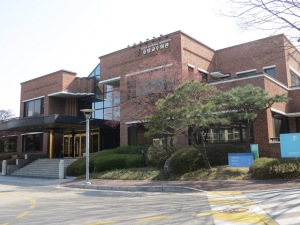
As I posted earlier, we visited Korea and Japan again in August/early September and had a wonderful time. The main reason for the visit was a conference Rod attended in Pyeong-chang at the SNU (Seoul National University) agricultural campus there. But we spent our first 4 days in Seoul on the main SNU campus, and then our last night, after Pyeong-chang, back in Seoul on the SNU campus again.
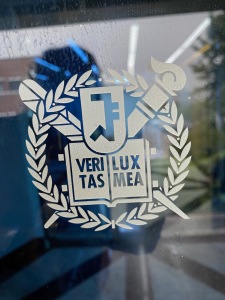
Rod’s contact at SNU, Dr. Myunggi Baik, booked us into the Hoam Faculty House on the edge of the Gwanak SNU campus, the main campus in south Seoul. We had stayed there for almost a month in spring 2016, when Rod conducted a special workshop at SNU, and we enjoyed it a lot. Here’s a link to my blog post at that time:
https://vivskoreanadventures.wordpress.com/tag/hoam-faculty-house-snu/
So, we were happy to be back in the Hoam Faculty House, a great place for international visitors to the university to stay. The guest rooms in the building next to the main building are comfortable, there are two restaurants, various conference rooms and a convention hall for international conferences and seminars. We enjoyed a number of very good meals in the restaurant there.
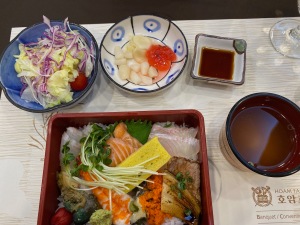
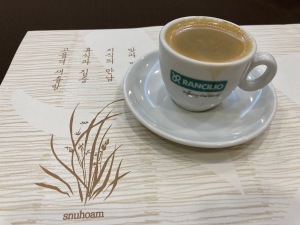
It is also the final stop for bus 6017 that goes to and from Incheon Airport, which is very convenient. In addition, a 20-minute walk takes you to a shopping area (with convenience stores, coffee shops, noodle restaurants etc) and the Nakseongdae Subway stop—Green line—part of the extensive subway system in Seoul.

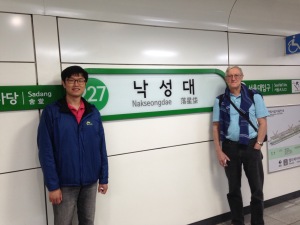
This visit, we found out more about the history of SNU and the origin of the name “Hoam”. Seoul National University originated from various educational institutions established by King Gojong of the Joseon dynasty in the late 1800s. SNU of that name was founded in August 1946 as the premier national university by merging these 10 institutions of higher education around the Seoul area. During the Korean War some classes were held at Busan Wartime Nations University, and after the Korean War there was reconstruction and expansion, 1954-1960.
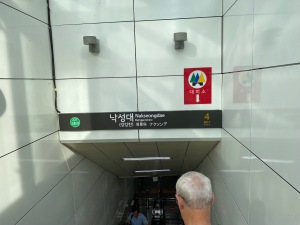
At that time, SNU had multiple campuses in different parts of Seoul. In the 1970s the president of Korea was Park Chung Lee, the army general who ruled the country until his assassination in 1979. There were many student protests during his time in office. President Park disliked student protests to such an extent that he requested a new SNU campus be built with all the downtown campuses moved to one place far removed from the downtown. In March 1970 Gwanak Mountainwas selected as the site of the new SNU campus, and in April 1971 construction of the newly integrated campus in Gwanak started. Apparently, the Gwanak mountain site originally belonged to Samsung CEO Lee Byung-chul and part of it was a golf course. President Park ordered Lee Byung-chul to donate the land.
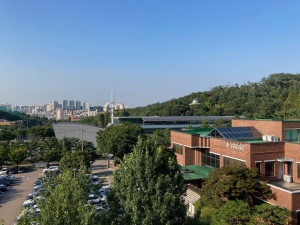
Starting in February 1975, most colleges of the university relocated to the new Gwanak campus and campus integration was complete when the College of Engineering moved to Gwanak campus in January 1980. Gwanak is the main campus, but SNU also had Yeongeon medical campus, and Suwon agricultural campus about 40 km (24 miles) south of Seoul. The Suwon campus has now been mostly replaced by a new agricultural campus in Pyeongchang in Gangwon Province.
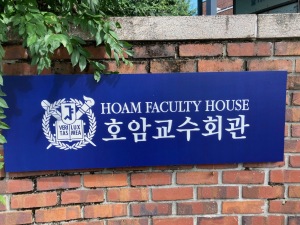
Hoam Faculty House opened in 1990 and is named after the Samsung CEO Lee Byung-chul, whose nickname was Hoam.




 But what was fascinating here was a huge piece of fossilized wood fenced off just outside the museum.
But what was fascinating here was a huge piece of fossilized wood fenced off just outside the museum.
 “When a tree dies and is exposed to the air, it is decomposed and decayed by microbes. However, when trees are buried quickly in the soil around swamps or mud, the wood component slowly is changed to contents that are dissolved in underground water. If this continues for a long time, the wood components will be removed, but the structure or shape will be preserved and became a fossil. Most wood fossils are filled with silicon dioxide. In Korea, they are mainly found in Gyeongsang-do (also written Kyungsangdo).” This includes numbers 2,3,7,14,15 areas in the map.
“When a tree dies and is exposed to the air, it is decomposed and decayed by microbes. However, when trees are buried quickly in the soil around swamps or mud, the wood component slowly is changed to contents that are dissolved in underground water. If this continues for a long time, the wood components will be removed, but the structure or shape will be preserved and became a fossil. Most wood fossils are filled with silicon dioxide. In Korea, they are mainly found in Gyeongsang-do (also written Kyungsangdo).” This includes numbers 2,3,7,14,15 areas in the map.





 We’d walk around and see a splash of vivid white color on the dark background of the hills, or lining the streets. It made such a contrast, especially if near the yellow forsythia. You don’t see just individual flowers, but a big patch that’s totally white. They look illuminated, especially when looking out on the hills, and away from streets. Petals drift down slowly, like the first soft snow flakes of winter. There were many trees in the city parks too, so we realized that cherry blossoms are a big part of Korean culture too. They are a metaphor for the ephemeral nature of life—the transience of the blossoms, their exquisite beauty and volatility, is often associated with mortality.
We’d walk around and see a splash of vivid white color on the dark background of the hills, or lining the streets. It made such a contrast, especially if near the yellow forsythia. You don’t see just individual flowers, but a big patch that’s totally white. They look illuminated, especially when looking out on the hills, and away from streets. Petals drift down slowly, like the first soft snow flakes of winter. There were many trees in the city parks too, so we realized that cherry blossoms are a big part of Korean culture too. They are a metaphor for the ephemeral nature of life—the transience of the blossoms, their exquisite beauty and volatility, is often associated with mortality.

 Cherry blossoms are beloved around the world. Besides being beautiful and attracting visitors, cherry blossoms have special meaning and significance in Korea, China, and especially Japan. There are also famous cherry blossom trees in Washington D.C.
Cherry blossoms are beloved around the world. Besides being beautiful and attracting visitors, cherry blossoms have special meaning and significance in Korea, China, and especially Japan. There are also famous cherry blossom trees in Washington D.C.



 There is a wide variety of cherry trees but the most common is Somei Yoshino (Prunus Yedoensis), named after its place of origin—Yedo, current day Tokyo. Somei village (current day Toshima) is a ward in the northern area of Tokyo. Their flowers are nearly pure white tinged with the palest pink, especially near the stem. They bloom and usually fall within a week.
There is a wide variety of cherry trees but the most common is Somei Yoshino (Prunus Yedoensis), named after its place of origin—Yedo, current day Tokyo. Somei village (current day Toshima) is a ward in the northern area of Tokyo. Their flowers are nearly pure white tinged with the palest pink, especially near the stem. They bloom and usually fall within a week. Cherry Tree. Before that they were called sakulanam, from the Japanese sakura (cherry blossom).
Cherry Tree. Before that they were called sakulanam, from the Japanese sakura (cherry blossom).
 Yet Koreans continued to plant Yoshino cherry trees, and festivals, including Yeouido and Jinhae, began attracting a wide range of tourists. As of 2017, most of the cherry trees planted in South Korea are Yoshino cherry trees known to have come from Japan or have been grafted from trees planted during the Japanese colonial period.
Yet Koreans continued to plant Yoshino cherry trees, and festivals, including Yeouido and Jinhae, began attracting a wide range of tourists. As of 2017, most of the cherry trees planted in South Korea are Yoshino cherry trees known to have come from Japan or have been grafted from trees planted during the Japanese colonial period.








 glorious, and later in the month the azalea bushes at the front of Hoam were a blaze of color. Very pretty to see and experience.
glorious, and later in the month the azalea bushes at the front of Hoam were a blaze of color. Very pretty to see and experience.
 Seoul National University celebrates 70 years this year
Seoul National University celebrates 70 years this year


















